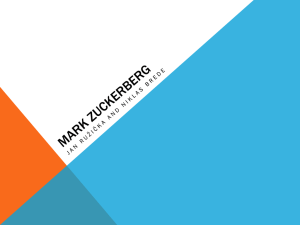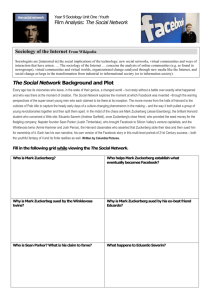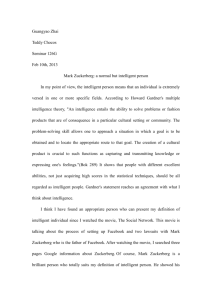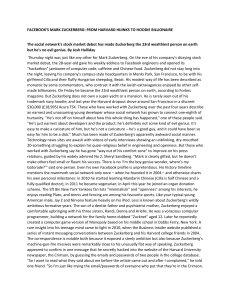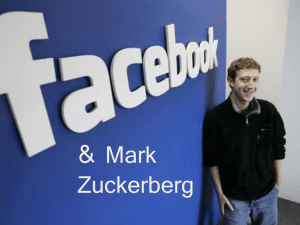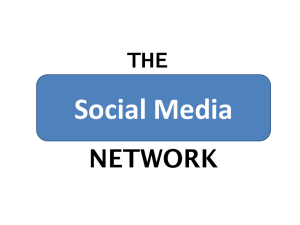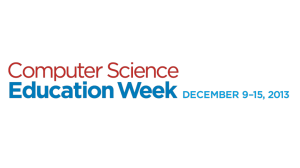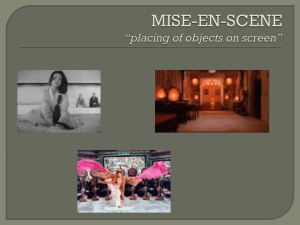Unit Powerpoint
advertisement
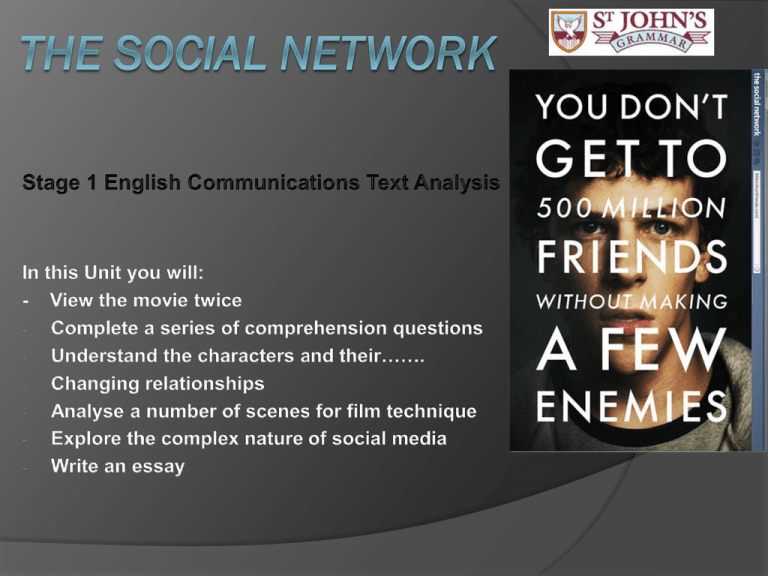
David Fincher Famous for portraying dysfunctional characters – eg Se7en, Fight Club, Panic Room Meticulous direction – notorious for the number of takes per scene. For instance, the opening scene of The Social Network had 99 takes! Here’s his list of films: ○ ○ ○ ○ ○ ○ Alien 3 Se7en The Game Fight Club Panic Room Zodiac The Curious Case of Benjamin Button The Social Network And the upcoming US version of The Girl with the Dragon Tattoo Aaron Sorkin Based the screenplay on Ben Mezrich novel The Accidental Billionaires. THE SOCIAL NETWORK IS NOT A DOCUMENTARY!! Most famous for his work on the hit TV series The West Wing Intense and often fast-paced dialogue is his hallmark Extremely well-respected in filmmaking circles Here’s a list of some of his films/TV shows: A Few Good Men • Malice The American President • The West Wing Charlie Wilson’s War • The Social Network As you (re)view the film take note of: - how the main characters’ relationships change as the film progresses – think about why this happens - how the events are portrayed with events cut and pasted in time - how the filmmakers create and sustain the drama Make sure you know what the CHRONOLOGICAL order of events is (as opposed to how they appear in the film). TASK: Create a TIMELINE from October 2003 to 2009 Boston – Harvard See the Wikispace for a Google Map of Harvard and the city of Boston Research: Why is Harvard such an important and prestigious University? What are Final Clubs? Which one did Mark want to get into? Palo Alto, California See the Wikispace for Google Maps of LA and the city of Palo Alto Research: Why is Palo Alto an important place to run a technology company? Find out a little about Stanford University Make some contrasting comments between Harvard and the Californian settings of the film. What are your experiences of Facebook? What do you see as its benefits and drawbacks? What did you think of the film? How did it make you feel? How did you respond to Mark? 'There's a difference between being obsessed and motivated,' Mark assures his girlfriend. What is Mark most passionate about? How much is he prepared to sacrifice in pursuit of his goals? 'I was your only friend - you had one friend,' Eduardo tells Mark across the deposition table. What is Mark and Eduardo's friendship like? Why did it break down? What did you make of the film's portrayal of Harvard's elitist culture? How did this influence the main characters? 'I'm six-five, 220 pounds and there are two of me,' says Tyler Winklevoss. What are the Winklevoss' strengths and weaknesses? Sean Parker: 'You know what's cooler than a million dollars?' Eduardo Saverin: 'You?' Sean Parker: 'A billion dollars.' How are the themes of 'coolness' and money played out through the film? Facebook has around 500 million members worldwide. What impact has it had on our culture? 'Who are you? . . . I mean, what do you do?' Mark asked junior lawyer Marylin Delpy. In what ways does Facebook encourage us to define ourselves? How does this affect our concept of identity? 'As if every thought that tumbles through your head was so clever it would be a crime for it not to be shared,' Mark's ex Erica snaps at Mark. Why are people drawn to the idea of broadcasting their personal lives on the internet? 'The internet's not written in pencil, Mark. It's written in ink,' states Erica, seething at the comments he blogged about her. Why is the typed word so powerful? Why is it tempting to misuse this power online? What positive things can social-networking sites achieve when used to their full potential? '[Mark's] from a logged-in, left-out generation that knows little of beauty and even less of feeling,' says Empire. Do you agree, and why/why not? How might this generation resolve these problems and learn to connect with people on a deeper level? By the end of the film, what judgments - if any - do you think the film ultimately makes about Mark and the creation of Facebook? Mark Zuckerberg The Protagonist What does this term mean? In what ways is Mark a protagonist? Does the audience like or dislike him (or both)? Why? Describe his: Physical attributes Personality Key Relationships Eduardo Sauverin The Mentor Despite their falling out, Eduardo is Obi Wan Kenobi to Mark’s Luke Skywalker. In what ways? Why does Mark ‘betray’ him? Describe his: Physical attributes Personality Key Relationships Erica Albright The Attractor What is an attractor? Why is Erica so important to Mark and the story line? Describe her: Physical attributes Personality Key Relationships The Winkelvoss twins The Nemesis What does this mean and in what ways do the ‘Winkelvii’ fulfill this role for Mark? Describe their: Physical attributes Personalities (and how they differ) Key Relationships Sean Parker The Trickster This classic character type is also known as a “Shapeshifter”. Why is this an appropriate description of Sean? Describe his: Physical attributes Personality Key Relationships THE KEY THEME IS CONFLICT Between ‘us’ and ‘them’ Within us Within them In real life we try to avoid conflict, in art (and especially movies) we are drawn to conflict. Why? - Exciting - Creates energy - Outcome is uncertain - Emotional – It’s entertaining List examples of conflicts we see in the film eg Mark vs. Erica (at the beginning) That theme is in play primarily between Zuckerberg and Eduardo Saverin, but also Zuckerberg and Erica (albeit a friendship with an abrupt end), Zuckerberg and Sean Parker (however Zuckerberg discovers he's bonded with a Trickster), and the general camaraderie of that initial Facebook team. Most prominently with Zuckerberg and Saverin, but also Zuckerberg and Erica, Parker and his relationship with Zuckerberg, Zuckerberg and the Winklevoss twins. Essentially Zuckerberg demonstrates loyalty to development and growth of Facebook, but none to any person other than Parker who in the end commits an act of disloyalty by getting busted and generating negative press for Facebook. Zuckerberg and the Winklevoss twins, Zuckerberg and the Harvard administration, Zuckerberg and the Harvard elite, Zuckerberg (buoyed by his success with Facebook) and all his legal inquisitors. Arguably it is Zuckerberg's sense of second-class status (in part) that fuels his desire to succeed. Zuckerberg vs. Harvard elite (Mr. Outside looking In), the Winklevoss twins vs. Zuckerberg (for his success with Facebook), Zuckerberg vs. the world (his sense that everyone basically is jealous of what he has created with Facebook). Every major character in the movie is either in power, wanting to gain more power, out of power and wanting in, or using whatever power they have to impact someone else (e.g., Erica uses her emotional power to dump Zuckerberg, so he responds by using his intellectual power to create a blog and demean Erica publicly). Zuckerberg becomes a billionaire by creating a social network platform based on the premise of people wanting to make connections... while he himself is unable to make any sort of genuine human connection. This point is driven home by the movie's brilliant final scene: Here is Zuckerberg, stripped of all the noise, all the people, all the fury, revealed for what he is: The Tragic King. He has built a mighty kingdom. And yet has no real friends, reduced to reaching out to a girl we've seen all of four times in the movie. Technique One – Time manipulation The film mixes timeframes continually. It goes from two litigation sessions (one with Eduardo Sauverin, and the other with the Winkelvoss twins and their partner Divya Narendra) back in time to retell events from different perspectives. Why did the filmmakers choose to tell the story in this way? In what ways was this technique confusing? Did you get used to it? Would telling this story in a chronological order have made it a better or worse film? Explain your response. Technique Two – The Eyes Eyes are significant in literature, theatre and of course cinema. The Social Network’s director David Fincher has been described as a ‘portraiture director’ – storytelling through the face, and in particular the eyes. As you watch a scene, take special note of how each character’s eyes are communicating and HOW the film achieves that. Technique Three – The Soundscape The Social Network’s soundscape is an integral part of the storytelling. It is a film with intense and rapid dialogue which had to be heard but also with the soundscape of realistic settings. How would you describe the music used? Who wrote it? From the Wikispace – check out the links for soundscape discussion
